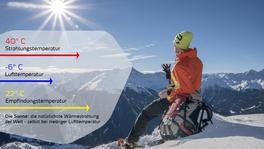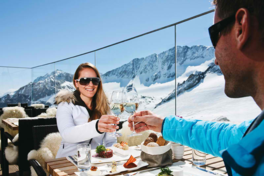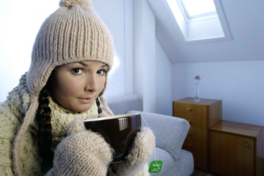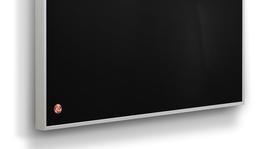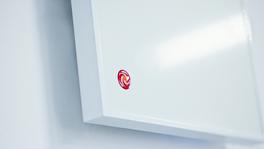Funktionsweise
Strahlungswärme – natürlich wie die Sonne
Stellen Sie sich vor, Sie sitzen draußen in der Natur. Sonnenstrahlung wärmt Sie angenehm, Sie sind herrlich entspannt. Wäre es nicht wunderbar, dieses angenehme Gefühl in Ihre Wohnräume zu holen?
Mit einer echten Infrarotheizung geht Ihr Wunsch in Erfüllung. Denn diese strahlt Infrarotwärme aus, genau wie die Sonne es schon von Anbeginn der Zeit an tut – es ist die natürlichste Wärmestrahlung der Welt. Das Prinzip dafür ist uralt: Seit Sonnenstrahlen auf den Erdboden auftreffen, beziehen alle Lebewesen unseres Planeten ihre Energie daraus. Die Zuwendung zum Notwendigen löst die Natur über das Lustprinzip: Wirkt das auf Lebewesen, was Ihnen gut tut, dann löst dies Glücksgefühle aus. Verwenden Sie easyTherm® und Sie werden es merken.
3 Wellen – unterschiedliche Wirkungen
Das Spektrum der Infrarotstrahlung ist breit; dieser Teil der elektromagnetischen Wellen wird in IR-A (kurzwelliges Infrarot von rot glühenden Strahlern), IR-B und IR-C (langwelliges IR) geteilt. Während kurzwelliges Infrarot eher in den Infrarotkabinen zu finden ist, wo starkes Schwitzen gewünscht ist, wird für Raumheizungen langewelliges IR-C benötigt, welches der uns permanent einwirkenden Wärmestrahlung jeder Oberfläche in unserer Nähe gleicht. Menschen bleiben trocken und die Verteilung im Raum funktioniert so am besten. Gemäß der Planck’schen Strahlungsgesetze senden alle Oberflächen ständig Infrarotstrahlung aus. Am behaglichsten, mit der größten Wirkungstiefe ist dabei der Wellenlängenbereich des IR-C. Sanft einwirkende Wärmewellen lösen Gefühle wie Behaglichkeit, Gemütlichkeit und Wohlempfinden aus.

1°C ist gleich 1°C - stimmt das?
Gesamtlösung und Design
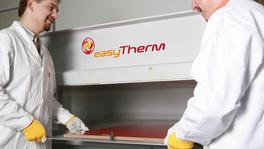
Das Produkt - präziser Fertigung
Damit eine Infrarotheizung – also eine Strahlungsheizung – richtig funktioniert, braucht es nicht nur eine Ausbildung zum Heizungstechniker, Gebäudetechniker oder Thermodynamiker. Intensive Kenntnisse über die Wirkungsweise von elektromagnetischen Wellen (Infrarot und Licht sind solche), ihre Ausbreitung und ihre Wechselwirkung mit Oberflächen werden benötigt. Dies beherrschen Nachrichtentechniker und Photoniker; sie sind bei easyTherm® mit an Bord.
Daher ist eines klar: eine Front aus Keramik und eine strahlungsminimierende Rückseite ohne jegliche Oxidschicht sind für optimale Ergebnisse nötig. Genauso wichtig sind mit anerkannten Forschungsstätten wie Fraunhofer entwickelte Komponenten. Nach gewissenhafter Entwicklung und ebenso gewissenhaftem Design und präziser Fertigung genießen Sie die Produktmerkmale ohne Veränderung der Eigenschaften für viele Jahrzehnte.
Das System - Wartungsfreiheit und Energieeinsparung
Alle gewohnten Heizungen bestehen aus Wärmeerzeugung, Wärmeverteilung, Wärmeabgabesystemen und Regelungen. Bei der easyTherm® Infrarotheizung wird jedoch kein Verteilungssystem benötigt; dies erfüllt die vorhandene 230V-Stromleitung. Wärmeerzeugung und -abgabe sind in einem Infrarotpaneel effizient zusammengefasst, weshalb bei easyTherm® 100% der (elektrischen) Energie in Wärme umgewandelt wird.
Auch Regelungen haben einen Einfluss auf Energieeinsparung und Behaglichkeit. Die Thermostatsysteme von easyTherm® sind dabei bestens auf die Wirkungsweise von Infrarot abgestimmt. Durch die Wartungsfreiheit des gesamten Heizungssystems wird das Leben einfacher und günstiger. Sie erleben mit dem Gesamtsystem höchste Behaglichkeit und sparen dabei Energie und Kosten.
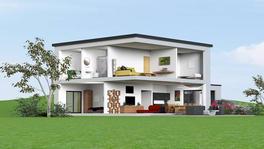
Die Lösung
Selbst die beste Funktionsweise von Geräten und Systemen reicht nicht zum Erreichen von Behaglichkeit. Die Infrarotheizung steht in Wechselwirkung mit Räumen und Gebäuden. Daher lassen die easyTherm® Ingenieure und Partner auch sämtliche Gebäudedaten in Heizlastberechnungen einfließen. Kostenlos und unverbindlich erfolgt dies beim Neubau durch Bauplanstudium und im Bestandsbau durch eine gewissenhafte Erfassung vor Ort.
Die erhobenen bauphysikalischen Eigenschaften, das Standortklima sowie Ihr individuelles Nutzungsverhalten fließen in die Heizlastberechnungen und Angebotslegungen ein. Für Sie ein kostenloser Weg zur besten Heizung!
Vier Geheimnisse der Behaglichkeit
Wärme von überall
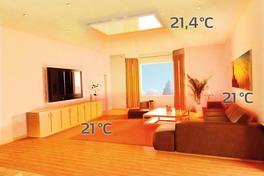
Hier sorgen Wärmewellen auch für sekundäre Abstrahlung von Wänden, Decke und Boden – also angenehme Erwärmung rundum. Das ist entscheidend für das Wohlbefinden. Sie brauchen außerdem für eine gefühlte Temperatur von 21°C tatsächlich nur etwa 18°C Raumtemperatur.
Keine kalten Füße
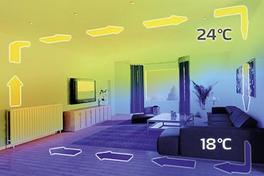
Die herkömmliche Heizung durch erwärmte Luft erzeugt je nach Raumhöhe steigende Temperaturen, da warme Luft nach oben strömt. Die Folge sind kalte Füße und ein gut erwärmter Plafond – also teure ungenutzte Wärme oben an der Decke. easyTherm® schafft Abhilfe ohne Zugluft.
In beheizten Wohnräumen fühlen Sie sich dann am wohlsten, je geringer der Unterschied zwischen Oberflächentemperaturen und Lufttemperatur ist. Echte Infrarotheizungen mit einem hohen Strahlungswirkungsgrad erfüllen diese Anforderung. Hochwertige Infrarotpaneele erwärmen in erster Linie nicht die Luft, sondern die Raumhülle, Oberflächen und den Menschen selbst.
Optimale Luftfeuchtigkeit
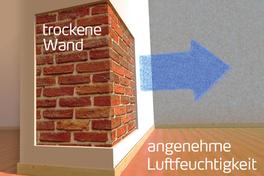
Wärmewellen bewirken, dass die Luftfeuchtigkeit von den wärmeren Wänden in die kühlere Luft abgegeben wird.
Angenehme Luftfeuchtigkeit, für die Atemwege besseres Raumklima und trockene, auch gegen Schimmelbildung resistente Wände, sind die Vorteile.
Keine feuchten Wände mit Infrarot
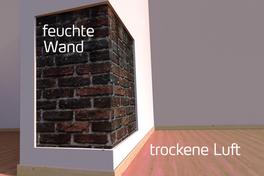
Herkömmliche Heizungen erwärmen die Luft stärker als die Wände. Daher wird die Feuchtigkeit der Luft von der Wand aufgesogen. Folgen sind trockene Luft, feuchte Wände mit schlechter Wärmedämmung und sogar Schimmelbildung (vor allem in Ecken und hinter Möbeln).
easyTherm® Wärmewellen verhindern diese Effekte.

